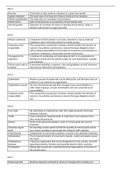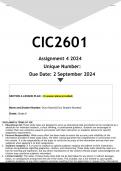Unit 3:
Revenue Total value of sales made by a business in a given time period.
Capital employed The total value of all long-term finance invested in the business.
Market capitalisation The total value of a company’s issued shares.
Market share Sales of the business as a proportion of total market sales.
Internal growth Expansion of a business by means of opening new branches, shops or
factories (also known as organic growth).
Unit 4:
Mission statement A statement of the business’s core aims, phrased in a way to motivate
employees and to stimulate interest by outside groups.
Corporate social The concept that accepts that a business should consider the interests of
responibility society in its activities and decisions, beyond the legal obligations that it
has by taking responsibility for the impact of its decisions and activities on
customers, employees, communities and the environment.
Management by A method of coordinating and motivating all staff in an organisation by
objectives dividing its overall aim into specific targets for each department, manager
and employee.
Ethical code (code of A document detailing a company’s rules and guidelines on staff behaviour
conduct) that must be followed by all employees.
Unit 5:
Stakeholder People or groups of people who can be affected by, and therefore have an
interest in, any action by an organisation.
Stakeholder concept the view that businesses and their managers have responsibilities to a
wide range of groups, not just shareholders (see also corporate social
responsibility).
Corporate social The concept that accepts that a business should consider the interests of
responsibility society in its activities and decisions, beyond the legal obligations that it
has
Unit 6:
Free trade No restrictions or trade barriers exist that might preventor limit trade
between countries.
Tariffs Taxes imposed on imported goods to make them more expensive than
they would otherwise be.
Quotas Limits on the physical quantity or value of certain goods that may be
imported.
Voluntary export An exporting country agrees to limit the quantity of certain goods sold to
limits one country (possibly to discourage the setting of tariff s/quotas).
Protectionism Using barriers to free trade to protect a country’s own domestic industries.
Globalisation The increasing freedom of movement of goods, capital and people around
the world.
Multinational A business organisation that has its headquarters in one country, but with
business operating branches, factories and assembly plants in other countries.
Privatisation Selling state-owned and -controlled business organisations to investors in
the private sector.
Unit 7:
External growth Business expansion achieved by means of merging with or taking over
, another business, from either the same or a different industry.
Merger An agreement by shareholders and managers of two businesses to bring
both fi rms together under a common board of directors with shareholders
in both businesses owning shares in the newly merged business.
Takeover When a company buys over 50% of the shares of another company and
becomes the controlling owner of it. It is often referred to as ‘acquisition’.
Synergy Literally means that ‘the whole is greater than the sum of parts’, so in
integration it is often assumed that the new, larger business will be more
successful than were the two formerly separate businesses.
Unit 8:
Social audit A report on the impact a business has on society. Th is can cover pollution
levels, health and safety record, sources of supplies, customer satisfaction
and contribution to the community.
Information The use of electronic technology to gather, store, process and
technology communicate information.
Innovation Creating more eff ective processes, products or ways of doing things in a
business. Insolvent: when a business cannot meet its short-term debts
Computer-aided The use of computer programs to create two- or three-dimensional (2D or
design 3D) graphical representations of physical objects.
Environmental audit Assess the impact of a business’s impact on the environment.
Monopoly Theoretically a situation in which there is only one supplier, but this is very
rare. For government policy purposes this is usually redefi ned as a
business controlling at least 25% of the market.
Pressure groups Organisations created by people with a common interest or aim, and that
put pressure on businesses and governments to change policies so that an
objective is reached.
Unit 9:
Economic growth In increase in a country’s productive potential measured by an increase in
its real GDP.
Gross domestic The total value of goods and services produced in a country in one year –
product (GDP) real GDP has been adjusted for infl ation.
Business investment Expenditure by businesses on capital equipment, new technology and
research and development.
Business cycle The regular swings in economic activity, measured by real GDP, that
occur in most economies, varying from boom conditions (high demand
and rapid growth) to recession when total national output declines.
Recession A period of six months or more of declining real GDP
Inflation An increase in the average price level of goods and services. It results in a
fall in the value of money.
Deflation A fall in the average price level of goods and services.
Working population All those in the population of working age willing and able to work.
Unemployment This exists when members of the working population are willing and able
to work, but are unable to find a job.
Cyclical Unemployment resulting from low demand for goods and services in the
unemployment economy during a period of slow economic growth or a recession.
Structural Unemployment caused by the decline in important industries leading to
unemployment significant job losses in one sector of industry.
Frictional Unemployment resulting from workers losing or leaving jobs and taking a
unemployment substantial period of time to find alternative employment.
Balance of payments This account records the value of trade in goods and services between
(current account) one country and the rest of the world. A deficit means that the value of
, goods and services imported exceeds the value of goods and services
exported.
Exchange rate The price of one currency in terms of another.
Exchange rate A fall in the external value of a currency as measured by its exchange rate
depreciation against other currencies. If $1 falls from €2 to €1.5, the value of the dollar
has depreciated.
Exchange rate A rise in the external value of a currency as measured by its exchange
appreciation rate against other currencies. If $1 rises from €1.5 to €1.8, the value of
the dollar has appreciated.
Imports Goods and services purchased from other countries.
Exports Goods and services sold to consumers and business in other countries.
Fiscal policy Is concerned with decisions about government expenditure, tax rates and
government borrowing. These operate largely through the government’s
annual budget decisions.
Government budget The value of government spending exceeds revenue from taxation.
deficit
Government budget Taxation revenue exceeds the value of government spending.
surplus
Monetary policy Concerned with decisions about the rate of interest and the supply of
money in the economy.
Market failure When markets fail to achieve the most efficient allocation of resources
and there is under- or over-production of certain goods or services.
External costs Costs of an economic activity that are not paid for by the producer or
consumer, but by the rest of society.
Income elasticity of Measures the responsiveness of demand for a product aft er a change in
demand consumer incomes.
Unit 13:
Hard HRM An approach to managing staff that focuses on cutting costs, e.g.,
temporary and part-time employment contracts, offering maximum
flexibility but with minimum training costs.
Soft HRM An approach to managing staff that focuses on developing staff so that
they reach self-fulfilment and are motivated to work hard and stay with
the business.
Part-time employment Employment contract that is for less than the normal full working week
contract of, say, 40 hours, e.g., eight hours per week.
Temporary Employment contract that lasts for a fixed time period, e.g., six months.
employment constract
Flexi-time contract Employment contract that allows staff to be called in at times most
convenient to employers and employees, e.g., at busy times of day.
Outsourcing Using another business (a third party) to undertake a part of the
production process rather than doing it within the business using the fi
rm’s own employees.
Teleworking Staff working from home but keeping contact with the office by means
of modern IT communications.
Zero-hours contract No minimum hours of work are offered and workers are only called in
when work is available.
Labour Productivity The output per worker in a given time period. It is calculated by
(total output in time period, e.g., 1 year)/ (total staff employed)
Absenteeism Measures the rate of workforce absence as a proportion of the employee
total.
Workforce planning Analysing and forecasting the numbers of workers and the skills of those
workers that will be required by the organisation to achieve its
objectives.






